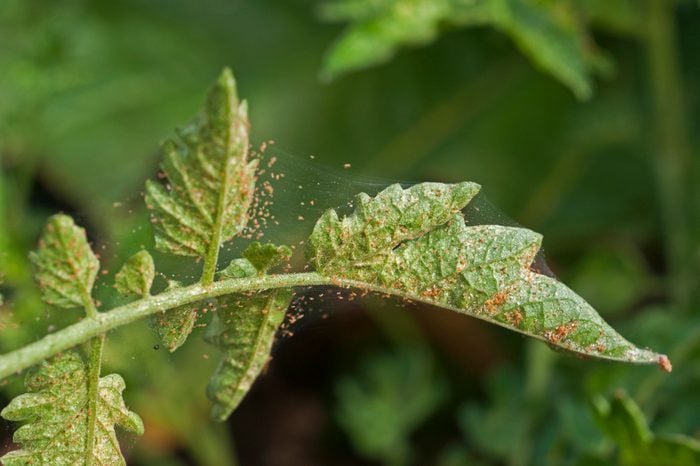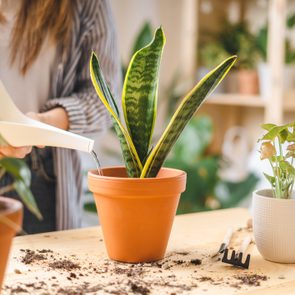How to Get Rid of Spider Mites
Updated: May 24, 2023

Nothing ruins the joy of your indoor garden faster than an infestation. Here's how to get spider mites out of your plants and your home.
If you’ve ever noticed tiny, moving dots on your houseplants, odds are good you’re dealing with a case of spider mites. What do spider mites look like? Adult females are less than 1/20-inch long, and they have eight legs and an oval-shaped body that can be several different colors. They live in colonies, mostly on the undersides of leaves, and a single colony may have hundreds of them.
Spider mites can turn even low-maintenance indoor plants into a project, but if you don’t do anything about them, there’s a chance you’ll wind up with a dead plant, as they’ll feast on the leaves, leaving them yellow, dry or stippled. And there are other ways to know if you need spider mite treatment too.
“The telltale signs of spider mites are fine, silky webbing (not to be confused with regular spider webs, which are more fishnet-style rather than fine silken cloth) and pale markings that look like someone poked the leaf with pale white or grey dots, as well as occasional black dots,” says horticulturist Christopher Satch, a plant consultant and professor with the New York Botanical Garden.
Spider mites, like any creature, prefer an easy meal. They like thin-leafed orchids and are much less common on thicker plants, like succulents. “Spider mites are attracted to bright colors, especially yellow, and they gravitate toward the sunniest part of the plant,” says Satch. Note, however, that this doesn’t mean low-light indoor plants are exempt from spider mite infestations.
If there’s any good news here, it’s that spider mites are vegan, so they won’t harm you—or your pets. But if you don’t want to have to buy plants online to replace the ones that have died, here’s how to get rid of spider mites on your indoor plants.
What are spider mites?
Spider mites are not insects. They are arachnids related to spiders, and there are many different species of mites—some good, some bad. “The good mites are predatory and feed on other mites and other plant pests,” says Satch. “Bad mites, such as spider mites, are quite destructive and are very easily missed, as they are so small.”
Spider mites feed by cutting open individual plant cells and drinking the cellular guts. This mode of feeding means that systemic insecticides, which are put into the soil, won’t work. Spider mites must be treated with contact insecticides, says Satch, which are applied topically to the leaves. That’s why it’s so important to know how to get rid of spider mites: Other remedies used to get rid of fungus gnats or get rid of aphids won’t work!
The entire life cycle of spider mites, from egg to adult, depends on the temperature inside your home; it can range from 40 days at 55 degrees to five days at 75 degrees, and females can lay up to 200 eggs at a time. “This makes them rather problematic, especially at blooming time, or during times of new growth,” Satch says.
What causes spider mites?
Where do spider mites come from? They wind up living in your plants if you bring home an infested plant or don’t treat your plants for pests, or they can blow in from the outside if your windows are below the tree line. “Spider mites can easily get on your clothes and hitch a ride,” says Satch.” You might be transferring them from plant to plant if you have an infestation and don’t shake your clothes out between working with different plants. Always be sure to check for mites and other pests before you repot a plant to stop the spread of infestation.
How can you get rid of spider mites?
Spider mites can be controlled best by insecticidal soaps or something stronger like a pesticide, or with predatory mites. Unfortunately, natural solutions aren’t very effective against spider mites on houseplants. “Neem oil does not work against spider mites, and neither does any other home remedy,” says Satch.
To get rid of spider mites when they’re indoors, three to four applications of pesticide, with intervals of a few days between them, will do the trick. “I recommend multiple applications of pesticides to control spider mites, or multiple applications of beneficial mites,” says Satch. If you don’t treat aggressively and repeatedly enough, you won’t get them all and the infestation will return.
Using predatory mites is a surprisingly neat method for how to get rid of spider mites. Amblyseius cucumeris are one of the many predatory mites you can use as a spider mite treatment. “Predatory mites are small just like the mites they eat, so if you were to release them in your apartment for spider mite control, they would exhaust their food supply and either leave or die and turn into dust—no bodies to clean up,” says Satch.
How can you prevent them?
It’s helpful to know how to get rid of spider mites, but it’s even better to keep them from hanging out on your plants in the first place. “Quarantining and treating your plants with insecticidal soap for a day or two (a few applications in the bathtub) will prevent mites from even entering your collection,” says Satch. And when you buy new plants, make sure to give the underside of the leaves a scan before you bring them inside your home. It also doesn’t hurt to scan for fungus balls or powdery mildew on plants to make sure your indoor garden stays healthy, disease-free and infestation-free.
Source:
- Christopher Satch, plant consultant and professor with the New York Botanical Garden



